The ASUS ZenBook 3 Review: A Convincing Case for Quad Core Thin & Light Laptops
by Brett Howse on November 22, 2017 8:00 AM EST- Posted in
- Laptops
- Asus
- Zenbook
- Core 8th Gen
- Kaby Lake Refresh
Powering the ZenBook 3: Quad-Core Kaby Lake Refresh
We can be a bit spoiled for entertainment in the technology industry, with new products being launched all the time that offer newer and better features. But it’s really only been a few times were the jump was something special. The move to multi-core was one of those moments, when the industry figured out they couldn’t keep increasing frequency forever.
It’s been about ten years since Intel made the jump from single-core to dual-core notebook processors for their low-voltage lineup. And while Intel has offered quad-core processors in their 45-Watt range since August 2008, anyone after a thin and light laptop featuring a Core processor has been required to settle for a dual-core CPU. Finally, that’s no longer the case. Although not all workloads scale well with multiple threads, those that have can really benefit from more cores; and even if a given workload isn’t heavily threaded, the expectation today from consumers is for strong multi-tasking performance.
The Kaby Lake Refresh CPU is part of Intel’s larger 8th generation Core CPU lineup, a lineup that is (frustratingly) a bit complex. All-told, the lineup is currently composed of two different CPU architectures – Kaby Lake Refresh and Coffee Lake – and will likely be joined by a third next year with Cannonlake. As implied by the name, Kaby Lake is a relatively straightforward development, with Intel releasing quad-core versions of their popular 15 Watt Kaby Lake-U CPUs. Architectually these new CPUs are not any different than their dual-core predecessors, but then they don't need to be, as adding another pair of cores alone adds quite a bit of performance. Right now these are the only 8th gen Core CPUs that are in laptops, but that's likely to change at CES 2018 in a couple of months.
Getting back to our laptop review, the top-end ZenBook 3 is offered with the Intel Core i7-8550U, featuring four cores, eight threads, and 8 MB of cache. The processor base frequency does drop compared to the dual-core models from last year, but the max turbo frequency is higher, so even if a workload is only single-threaded, it should offer more performance.
We’re going to have a deeper dive into the generational differences between Kaby Lake and Kaby Lake Refresh, so let this be a taste of what’s to come. Kaby Lake Refresh is mostly just a quad-core version of Kaby Lake, but the power requirements, even though the TDP has stayed the same, are quite a bit different. Let’s see what those changes do for performance.
For comparisons, we’ve put the ZenBook 3 up against a wide assortment of devices, from the quad-core Atom based Chuwi LapBook 14.1, to the latest Surface Pro with Core i7-7660U and Iris graphics, to the Dell XPS 15 9560, featuring a quad-core Kaby Lake 45-Watt CPU, just to get a feel for where the latest 15-Watt quad-core chip lands in the performance hierarchy. If you’d like to compare the ZenBook 3 to any other device we’ve tested, please use our online Bench.
PCMark

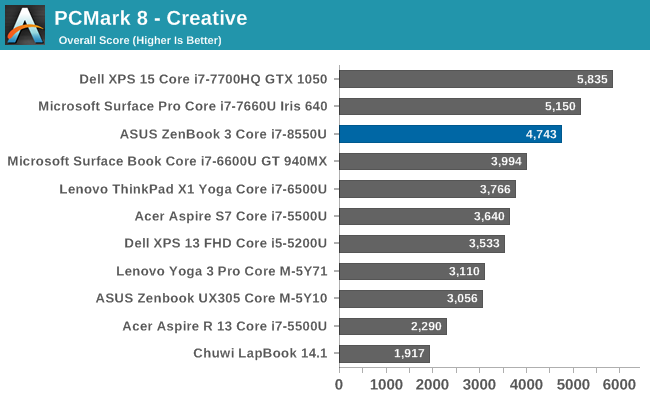
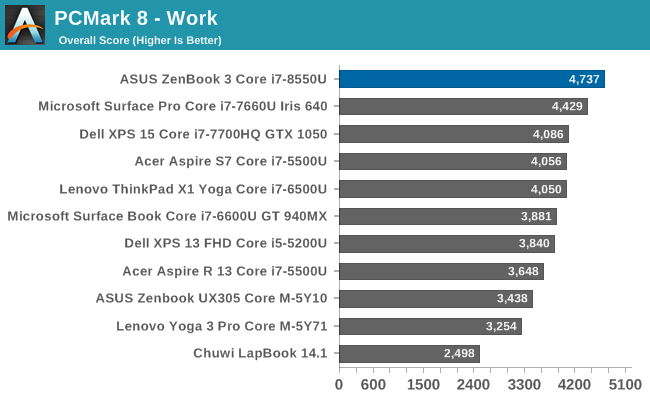
FutureMark’s PCMark suite is meant to test all aspects of a system, so these are not purely CPU bound results. The GPU can play an important part, especially in the Home and Creative tests, and even storage can play a part.
The ZenBook 3 lands near the top in all of the categories, despite being somewhat limited with the Intel UHD 620 GPU onboard. On the Work suite, which is the one that stresses the GPU the least, the latest 8th generation quad-core equipped notebook even finds itself right at the top. Not a bad start, especially for a 15-Watt laptop.
Cinebench

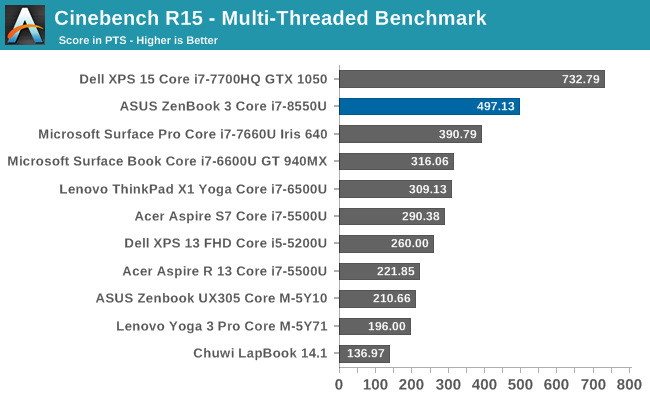
Cinebench offers a set of tests which can be selected to be single-threaded, or multi-threaded, so you can see how both sides of the equation work out. The single-threaded performance on this test puts Zenbook right at the top, but basically tied with both the Surface Pro, which also has a max turbo frequency of 4.0 GHz, and the higher wattage XPS 15, which peaks at 3.8 GHz. As expected, since this is a refresh of Kaby Lake and not a new architecture, the IPC is unchanged.
The multi-threaded test shows an impressive jump in performance over every other 15-Watt or less laptop in the list. As expected, it can’t keep up with the much higher thermal headroom of the 45-Watt Dell XPS 15, but it’s a large jump over even the Iris-equipped Surface Pro.
x264
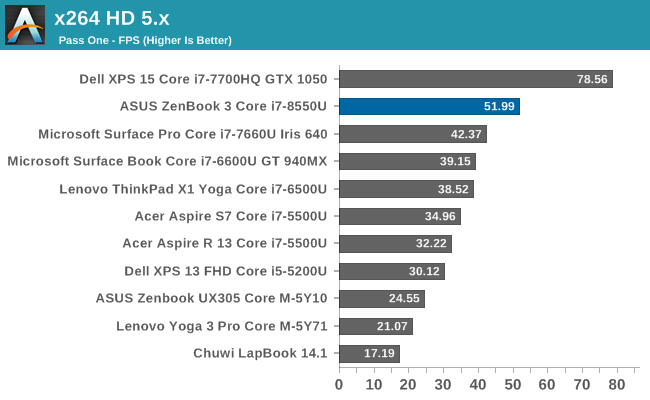
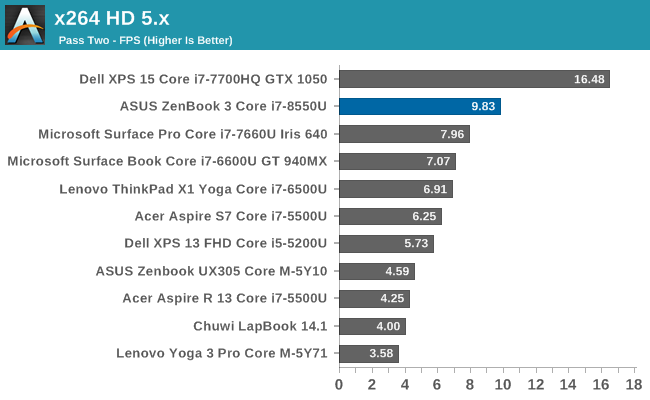
Much like Cinebench, x264 is a purely CPU test, and more cores, and higher frequencies, rule the roost. It doesn’t contain a single-threaded mode though, but instead encodes a video using the CPU in two passes. The test takes quite a while, meaning the device is sure to hit its maximum TDP.
Again, the ZenBook 3 outpaces all of the other devices with the same TDP or less than it, by a large margin. The extra cores don’t double the performance, but they do offer a lot more performance in the same TDP. The Dell XPS 15 with a 45-Watt processor shows that there’s lots of performance left on the table thanks to the low 15-Watt TDP of the i7-8550U.
Web Tests
A lot of what we do every day involves being in a web browser, and this is unlikely to slow down. Good web performance is always important, even though it’s only partially due to the device. Web browsers continue to improve performance, so this is never a static target, but it’s always great to see the progression over time.

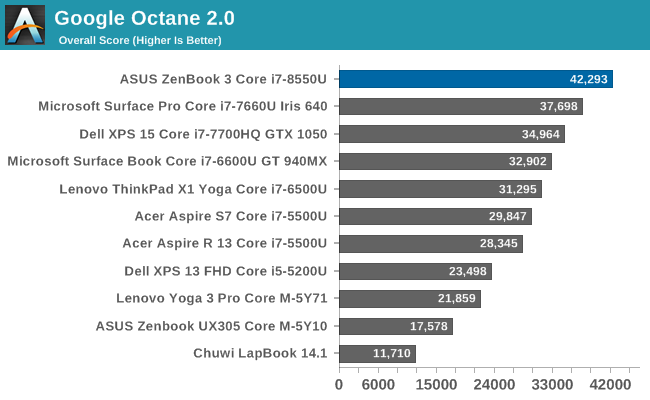

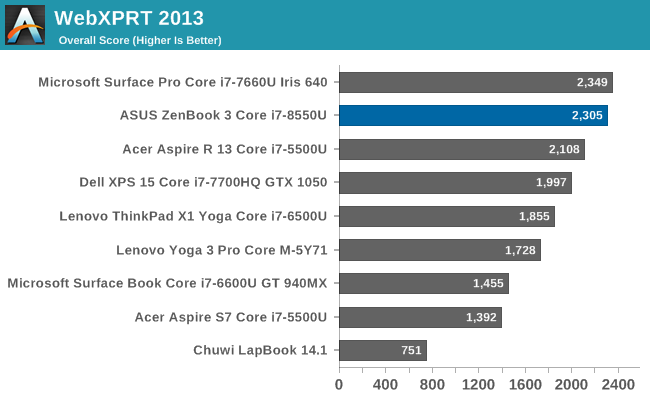
The jump to quad-core has helped out here quite a bit, as has the move to the latest Edge browser in the Fall Creators Update. The ZenBook 3 outperforms all other devices in these tests.
What can Quad do for you?
The move to quad-core in the U series from Intel has been a long time coming. For the last ten years, the maximum configuration offered by Intel was two cores/four threads, and doubling that to four cores/eight threads has shown that the move to quad-core CPUs has been a good one. For tasks that can utilize all of the threads, there’s a big increase in performance. Cinebench jumps over 25% compared to the Surface Pro i7 with the same max boost frequency. It’s true the core count has gone up 100%, but with four cores based on the same process as Kaby Lake, hitting the TDP was never going to be in doubt.
As long as the move to quad-core hasn’t impacted single-threaded performance, then it’s definitely a net win for customers, and thanks to Cinebench, we can see that single-threaded performance is exactly the same as Kaby Lake.
The only question will be cooling, and we’ll look at that in a bit.











55 Comments
View All Comments
aeronatis - Wednesday, November 22, 2017 - link
I believe they prefer to implement LPDDR to be able to reach long battery runtime during sleep. With standart DDR, any sleeping computer is pretty much out of juice overnight whereas laptops with LPDDR can sleep for days.DanNeely - Wednesday, November 22, 2017 - link
I've been able to sleep Dell Latitudes used by my previous employer over the weekend since the 2008(?) models; AFAIK all of them used standard DDR2/3 not low power sorts.hybrid2d4x4 - Thursday, November 23, 2017 - link
Overnight? That's a pretty major exaggeration. I had a Acer 3830TG (Sandy bridge, 4GB DDR3) that lasted >3 weeks in sleep. And before anyone says it, I always "powercfg -h off" on a new system/OS install.wolrah - Wednesday, November 22, 2017 - link
@labrats5 Who said anything about LPDDR3?@Jimios basically I'm looking for a powerful, portable machine on which to run VMs and do development. It'll never run games or even Windows so an nVidia or AMD GPU is just wasted silicon, wasted power, and annoying driver problems. I'd rather just use the Intel GPU that's built in to the processor and has great Linux support, but basically every proper workstation laptop forces a Quadro on you.
If I want to avoid the GPU I'm stuck looking at the thinner models. I don't really care about thin, I think my 2008-era Macbook Pro (the one right before unibody, that was basically an evolution of the Powerbook G4 design) was perfect as far as size/weight goes.
Jimios - Wednesday, November 22, 2017 - link
Can't the dGPU be completely disabled through BIOS/EFI or something? I haven't owned a non-Apple laptop recently so I honestly don't know.As for your use case (multiple VMs, etc.), I understand, but I don't think there would be too much demand for what you're asking. A laptop with your description wouldn't sell well to justify the development and marketing cost, IMO. Laptops like the article we're commenting on are mass market devices.
Also, typically with "workstation laptops" companies aim at CAD/CAM engineers and creative professionals. Which is sad, and I understand your frustration.
DanNeely - Wednesday, November 22, 2017 - link
As a developer currently using a Yoga with 16GB of ram, while I'd rather have a big laptop with a 45W CPU and 32GB of ram; if I could only have 1 I'd go for the ram multiple VMs or copies o Visual studio and a bunch of loaded browsers max out 16GB more often than I'm CPU limited.wolrah - Wednesday, November 22, 2017 - link
"Can't the dGPU be completely disabled through BIOS/EFI or something? I haven't owned a non-Apple laptop recently so I honestly don't know."I have yet to encounter a dual-GPU laptop where all the video ports were wired through the onboard GPU. Usually at least one of the external ports and sometimes the internal display is wired through the dedicated component, requiring that part to be enabled for those ports to work.
On my current Asus with a GT650M the HDMI port is wired through the nVidia chip so if I want to use an external monitor I have to either use VGA (yuck) or deal with the disaster that is nVidia Optimus. Even under Windows it's annoying, under Linux it's a mess.
linuxgeex - Thursday, November 23, 2017 - link
I've felt the same as you for the last decade, but you'd be surprised these days. AMD GPUs are quite well supported out of the box on open drivers, within 6mo of launch, and generally you can get them up on launch day using recent kernel/Mesa releases. I'll be getting an AMD 2500u based laptop this time around. Probably the Acer Swift.timecop1818 - Thursday, November 23, 2017 - link
> basically I'm looking for a powerful, portable machine on which to run VMs and do development. It'll never run games or even Windows so an nVidia or AMD GPU is just wasted silicon, wasted power, and annoying driver problems. I'd rather just use the Intel GPU that's built in to the processor and has great Linux support, but basically every proper workstation laptop forces a Quadro on you.you had me until "never runs Windows", lol.
nice troll, bro, nice troll.
also, accelerated graphics support in lunix. ha ha ha ha ha.
thanks for the laugh.
IGTrading - Wednesday, November 22, 2017 - link
It will be lovely to watch AMD Ryzen Mobile mop the floor with this 1700 USD waste of money.For this much money, I would expect way better performance, but luckily HP Envy x360z with Ryzen Mobile is just 600 USD.
There's nothing in ASUS' new Zen that's worth the extra 1000 USD they're asking.